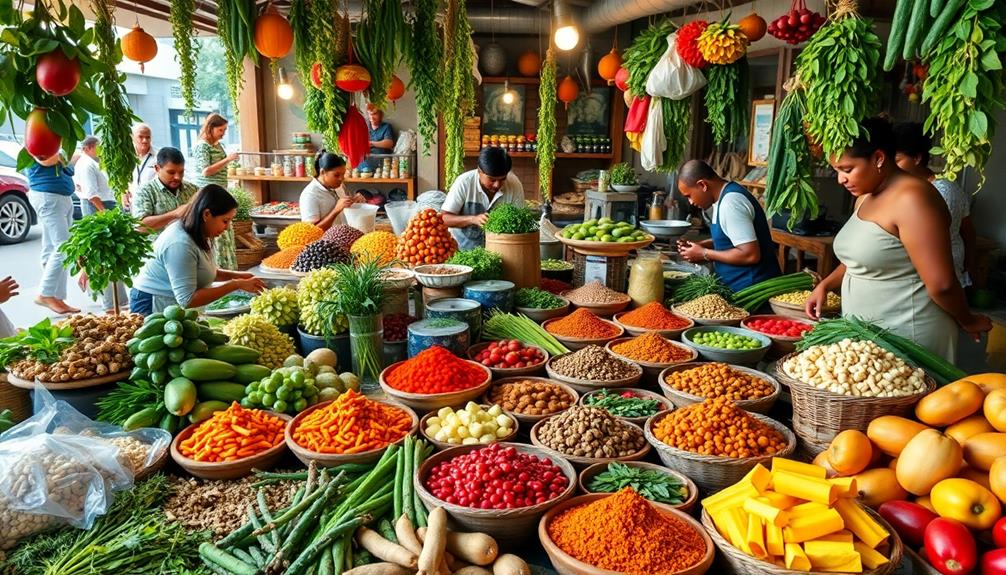Different cultures use food as medicine by integrating traditional practices with healing properties. In Traditional Chinese Medicine, foods are categorized to balance Yin and Yang, while Ayurveda tailors diets based on individual health needs. The Mediterranean diet promotes anti-inflammatory ingredients like olive oil, and Native American traditions emphasize local plants for their medicinal qualities. Even Western medicine is starting to recognize food's healing power. By understanding these diverse approaches, you can appreciate food's role in wellness. If you explore further, you'll uncover more fascinating insights into how food and medicine intertwine across various cultures.
Key Takeaways
- Ancient civilizations, including Greek and Chinese cultures, recognized food's healing potential, integrating it into their medicinal practices.
- Traditional Chinese Medicine categorizes foods to balance Yin and Yang, while Ayurveda tailors diets to individual dosha types for health.
- The Mediterranean diet emphasizes anti-inflammatory ingredients, showcasing the link between dietary choices and chronic disease prevention.
- Modern nutritional interventions advocate for whole foods and functional ingredients, reshaping health approaches through food-based therapies.
- Regulatory challenges exist globally, with Eastern food-medicine practices facing skepticism in Western markets, highlighting the need for integration.
Historical Perspectives on Food as Medicine
The idea that food can serve as medicine has roots that stretch back to ancient civilizations, where early practitioners recognized the healing potential of dietary choices. In Western medicine, the Hippocratic Corpus laid the groundwork for understanding how food functions as medicine, emphasizing the importance of diet in maintaining health.
Similarly, Traditional Chinese Medicine (TCM) underscores dietary therapy, categorizing foods based on their properties to balance Yin and Yang. In Ethiopian cuisine, for example, the use of ingredients like Yekolo (Roasted Barley) showcases how traditional foods are valued for their nutritional benefits and healing properties.
In Ayurveda, which dates back to the 2nd century CE, dietary principles align with individual dosha types and specific health conditions, demonstrating a systematic approach to food as medicine.
Ancient Greeks also believed in the balance of bodily humors, employing dietary interventions to correct imbalances, a concept that influenced European medical practices for centuries.
Moreover, indigenous cultures, including Native American communities, have long recognized the healing properties of various plants and foods, weaving this knowledge into their traditional medicine practices.
These historical perspectives highlight a universal understanding of food as an essential component in health and healing, showcasing a rich tapestry of traditions that continue to inform modern approaches to wellness.
Eastern Dietary Practices in Medicine
Exploring Eastern dietary practices reveals a fascinating integration of food and medicine that has shaped health philosophies for centuries. In both Traditional Chinese Medicine (TCM) and Ayurveda, food isn't just sustenance; it's an essential component of health.
TCM emphasizes the balance of Yin and Yang through foods categorized by tastes like sweet, sour, and bitter. This dietary therapy often takes precedence over medical interventions, reflecting a deep-rooted belief in the healing power of food. For instance, dishes like Red-Braised Pork Belly showcase how flavor and nutrition can intersect in traditional meals, highlighting the importance of ingredients in promoting well-being.
In Ayurveda, dietary recommendations are tailored to individual dosha types, utilizing concepts like Rasa (taste) and Guna (effects) to promote wellness.
Consider these key elements of Eastern dietary practices:
- The Shiliao Bencao text in TCM lists 109 food-medicine dual-use substances.
- Glycyrrhiza uralensis and Myristica fragrans are highlighted for their health benefits.
- Balancing tastes is essential for maintaining health in TCM.
- Ayurveda uses a holistic approach to tailor diets based on individual needs.
- Both traditions emphasize disease prevention through diet.
These practices highlight the rich, historical commitment to using food as a primary means of maintaining health and preventing illness.
Western Approaches to Food as Medicine
In Western medicine, you'll notice a shift towards recognizing the healing power of food, blending historical dietary practices with modern nutritional interventions.
Traditional Italian dishes, such as agnolotti and pasta with tomato sauce, showcase how regional ingredients can enhance nutritional value and promote health.
As you explore this topic, you'll find how traditional diets, like the Mediterranean, inform current health strategies that prioritize whole, nutrient-rich foods.
This approach not only enhances physical health but also addresses chronic disease management in innovative ways.
Historical Dietary Practices
Ancient Greece laid the groundwork for viewing food as an essential component of health, emphasizing the balance of the four humors: blood, yellow bile, black bile, and phlegm. This understanding led to historical dietary practices that sought to restore balance through specific foods tailored to individual conditions.
For instance, certain dishes, like those found in Brazilian Cuisine, incorporate ingredients believed to have medicinal properties, reflecting a cultural approach to food as a source of wellness. Galen, a key figure in Greek medicine, championed the role of diet in maintaining health, highlighting the medicinal benefits of foods like garlic and honey.
The Mediterranean diet, rooted in these traditions, is renowned for its association with lower rates of chronic diseases, showcasing how food choices can act as a form of medicine. During the Middle Ages, Arab scholars preserved Greek texts, enriching European dietary practices with food-based remedies and herbal treatments.
Consider these aspects of historical dietary practices:
- The four humors' influence on dietary choices
- Galen's emphasis on food for preventive care
- The Mediterranean diet's health benefits
- The integration of food-based remedies in medieval Europe
- The use of medicinal plants like okra and bitter melon for diabetes management
These elements reflect a long-standing recognition of food's therapeutic properties in Western medicine.
Modern Nutritional Interventions
Modern nutritional interventions are reshaping how healthcare professionals approach chronic diseases, emphasizing the essential role of diet in overall health. You'll find that integrating food-based therapies into clinical settings is becoming crucial for improving patient outcomes.
Research shows that probiotics, omega-3 fatty acids, and plant-based diets can effectively enhance mental health, reduce inflammation, and manage conditions like obesity and heart disease. Furthermore, incorporating fresh, seasonal ingredients like those found in dishes such as Nettle and Potato Soup can further amplify the nutritional benefits of a diet focused on healing.
The growing popularity of food as medicine concepts is evident in community programs that educate you on the health benefits of whole and functional foods. These initiatives promote dietary changes that serve as preventive care.
Health professionals are increasingly collaborating with nutritionists to create tailored dietary interventions aimed at specific health concerns, highlighting how nutrition plays a crucial role in holistic health approaches.
With mounting evidence supporting the effectiveness of food-based interventions, there's a strong push for policy support and more rigorous clinical trials. This movement seeks to validate both traditional and emerging dietary practices as legitimate components of modern healthcare.
As you explore these interventions, you'll recognize the profound impact that food can have as a form of medicine in your life.
Cultural Significance of Food-Medicine
When you explore the cultural significance of food as medicine, you'll uncover how historical practices shape modern dietary beliefs.
Different cultures have long viewed food not just as sustenance but as a powerful tool for healing and well-being.
For instance, Indian cuisine incorporates a variety of dishes like Mushroom Masala that are rich in spices known for their medicinal properties.
Historical Practices Overview
Throughout history, various cultures have recognized the powerful connection between food and medicine, illustrating how dietary choices can influence health and well-being. Traditional food practices have served as foundational elements in many societies, providing insights into the medicinal properties of our diets.
For instance, Traditional Chinese Medicine places significant emphasis on dietary therapy, with texts like Shennong's Classic of Materia Medica documenting food's healing abilities. Similarly, Ayurveda, dating back to the 2nd century CE, recommends foods tailored to individual health conditions and dosha status.
In African cultures, specific dishes like Muamba De Galinha are celebrated not only for their flavor but also for their cultural significance and perceived health benefits. You'll also find that ancient Greece linked the balance of bodily humors with dietary choices, prescribing specific foods to restore health.
Indigenous Native American practices highlight the use of local plants for medicinal purposes, underscoring food sovereignty's cultural significance. Finally, the Unani medicine system embodies the integration of food and herbal remedies for holistic health.
Cultural Dietary Beliefs
Cultural dietary beliefs shape how different societies view food's role in health and healing, reflecting a deep-rooted understanding of nutrition's power.
In Traditional Chinese Medicine (TCM), for instance, food therapy categorizes items based on their properties to balance the body's Yin-Yang. Everyday foods like rice porridge and tea are valued not just for nourishment but also for their medicinal qualities.
Similarly, Ayurveda advocates for dietary therapy that aligns food choices with individual dosha types, promoting health through specific tastes and effects.
In Japanese cuisine, dishes like Dorayaki (Red Bean Pancake) highlight the cultural significance of food as a source of comfort and pleasure, which can also play a role in overall well-being.
The Mediterranean diet illustrates another approach, emphasizing the health benefits of ingredients such as olive oil, garlic, and herbs, recognized for their anti-inflammatory and heart health properties.
Native American practices further highlight the cultural significance of wild plants in nourishing and healing communities, reinforcing the idea of food sovereignty.
Finally, Islamic Unani medicine draws on the balance of bodily humors, using food as a therapeutic means to maintain health.
These diverse approaches showcase how cultural dietary beliefs transform food into a powerful tool for healing, illustrating a shared understanding of food's integral role in well-being across different societies.
Food-Medicine Dual-Use Products
How do food-medicine dual-use products bridge the gap between nutrition and health? These products, recognized for their therapeutic benefits, integrate dietary and medicinal qualities, promoting overall well-being.
In China, for instance, 109 food-medicine dual-use substances have been identified, showcasing a rich tradition of using food as medicine. Similarly, in Indonesia, traditional dishes like Kue Putu highlight the use of natural ingredients such as coconut and palm sugar, which are celebrated for their health benefits.
While certain species like licorice and nutmeg are celebrated for their health benefits, many underutilized options, such as Solomon's seal, remain lesser-known in Western contexts.
Cultural acceptance plays a vital role in this integration. Many Eastern practices, including the use of mandarin orange and white mulberry, face skepticism in Western markets. However, globalization is changing perceptions, paving the way for herbal teas and functional foods to gain traction within health care.
Here are some highlights of food-medicine dual-use products:
- Combines nutrition and medicinal properties
- Supported by traditional practices, especially in China
- Offers potential health benefits like improved digestion
- Encourages holistic approaches to wellness
- Faces varying acceptance across cultures
Embracing these dual-use products could enhance your health journey, blending the best of both worlds.
Regulatory Challenges Across Cultures
Steering through the regulatory challenges surrounding food-medicine dual-use products reveals significant differences between Eastern and Western cultures. In China, the Food Safety Law clearly categorizes these dual-use products, while Western regulations tend to separate foods from therapeutic goods. This distinction can create barriers for Eastern products entering Western markets.
In Japan and South Korea, you'll find a more integrated approach to food and medicine, thanks to overlapping definitions for food with health claims and health functional foods. However, only 37 species recognized as food-medicine dual-use in China are deemed essential for healthy food use in Europe, showcasing cultural disparities in acceptance.
| Aspect | Eastern Cultures | Western Cultures |
|---|---|---|
| Regulatory Framework | Clear categorization | Separation of categories |
| Acceptance of Dual-Use | High acceptance | Limited recognition |
| Health Claims | Integrated approach | Strict standards |
| Market Access | Easier for local products | Significant barriers |
Bridging these cultural differences is crucial for enhancing regulatory frameworks and promoting the integration of traditional practices into modern healthcare systems.
Integration of Traditional and Modern Practices
The integration of traditional and modern practices in healthcare is becoming increasingly important as people seek holistic approaches to well-being. You might notice how traditional practices like Traditional Chinese Medicine (TCM) and Ayurveda emphasize food as medicine. TCM categorizes foods based on Yin-Yang properties, promoting balance and health, while modern research backs these claims with clinical evidence.
Similarly, Ayurveda tailors dietary choices to individual dosha types, with studies confirming the benefits of its ingredients. In Polish culture, traditional dishes like vegetable salad reflect a commitment to fresh, nutrient-rich ingredients that support health.
Here are some key points to reflect on:
- Traditional practices offer time-tested wisdom on food as medicine.
- Modern science validates the therapeutic effects of ancient dietary principles.
- Eastern dietary approaches are influencing Western health paradigms.
- Collaborative research is bridging the gap between traditional and contemporary nutritional science.
- A holistic understanding of diet's role enhances health across cultures.
As you explore these integrated practices, you'll discover how they can enrich your approach to health. Embracing both traditions and modern science allows for a more thorough view of nutrition, helping you make informed choices for your well-being.
Future Trends in Food as Medicine
As you explore the future of food as medicine, you'll notice a strong push for integrating global practices, especially Eastern medicinal traditions into Western healthcare.
This trend highlights the urgent need for rigorous research to validate these time-honored approaches while ensuring sustainable sourcing of medicinal plants.
Global Integration of Practices
How can we harness the wisdom of Eastern medicinal practices within Western health frameworks? As globalization expands, integrating traditional dietary practices like Traditional Chinese Medicine and Ayurveda into modern health systems is becoming more attainable.
You'll find that the concept of food as medicine is gaining traction, encouraging a deeper understanding of how diverse cultures approach nutrition and health.
- Explore dual-use products that function as both food and medicine.
- Participate in community initiatives promoting food as medicine principles.
- Learn about sustainable sourcing of medicinal plants and herbs.
- Engage in collaborative research efforts to validate traditional uses of food.
- Embrace cultural exchange to enhance awareness in the food-medicine sector.
This integration not only promotes healthier lifestyles but also enriches your understanding of global culinary traditions.
As awareness grows, you'll see more programs advocating for the adoption of these traditional dietary practices, blending ancient wisdom with contemporary health needs.
Research and Validation Needs
Integrating traditional dietary practices into modern health systems raises important questions about research and validation needs in the food as medicine movement. As globalization increases, you'll find that interest in Eastern medicinal practices is growing within Western markets. This creates opportunities for research collaborations aimed at validating the traditional uses of food as medicine.
However, there's a pressing need for rigorous clinical trials to substantiate health claims related to food-based interventions, which will address common misconceptions about this approach.
Moreover, regulatory frameworks vary across regions, presenting challenges for dual-use products trying to gain market access. Aligning traditional practices with modern standards is vital for their acceptance. Research efforts should focus on culturally specific dietary practices and their health impacts, enhancing understanding and acceptance of food as medicine among diverse populations.
In addition, sustainable sourcing practices for medicinal plants are essential to guarantee their long-term viability and marketability. This not only promotes cultural exchange but also facilitates knowledge sharing in the food-medicine continuum.
Sustainable Sourcing Initiatives
Sustainable sourcing initiatives play an essential role in ensuring the future of food as medicine, addressing both the growing demand for herbal remedies and the urgent need to preserve biodiversity.
With approximately 1 in 4 plant species at risk of extinction, it's imperative that you support practices that protect medicinal plants. As the herbal market is expected to reach $5 trillion by 2050, sustainable sourcing becomes increasingly significant.
Collaborative efforts between local communities and conservation organizations are fundamental for managing wild-harvested medicinal plants. These partnerships help balance economic needs with environmental sustainability.
Certifications like Fair Trade and organic labels are gaining popularity among consumers, influencing market trends and promoting ethical practices.
Here are some ways you can engage with sustainable sourcing initiatives:
- Choose products with sustainable sourcing certifications.
- Support local farmers and herbalists committed to ethical practices.
- Educate yourself on the medicinal plants native to your region.
- Participate in community programs focused on preserving biodiversity.
- Advocate for policies that protect endangered plant species.
Case Studies of Food in Healing
Numerous case studies highlight the transformative power of food in healing practices across different cultures. For instance, Traditional Chinese Medicine (TCM) utilizes dietary therapy to balance Yin and Yang, categorizing foods by their properties to promote health. Similarly, Ayurvedic practices focus on individualized dietary recommendations based on dosha types, emphasizing food as a primary approach to health maintenance.
Here's a quick overview of some healing food practices:
| Culture | Healing Food Practices |
|---|---|
| Traditional Chinese | Foods categorized by the five tastes to balance health. |
| Ayurveda | Dietary guidelines in the Charaka Samhita for disease prevention. |
| Native American | Utilizes wild plants, emphasizing their medicinal properties. |
Moreover, the Mediterranean diet, rooted in ancient Greek medicine, incorporates foods like olive oil and garlic, contributing to reduced chronic disease risk. These beliefs and practices demonstrate how food serves as a form of medicine, supported by ongoing medicine research. By understanding these case studies, you can appreciate the profound impact food has on health and wellness across diverse cultures.
The Role of Community in Food-Medicine
Food's healing power isn't just about individual choices; it's deeply rooted in community practices that have evolved over time. You can see this in various cultures where food acts as a conduit for health and connection.
For instance, Mexican communal meals often incorporate traditional medicinal ingredients, promoting shared health benefits. Similarly, Traditional Chinese Medicine emphasizes community knowledge, where balancing Yin and Yang through diet becomes a collective endeavor.
Many Indigenous communities focus on local plants and herbs, linking cultural identity with community health practices. These traditions are often passed down, reinforcing the bond between food and healing.
In addition, community health initiatives like gardens and cooking classes highlight the importance of traditional diets in preventing chronic diseases.
By engaging with others, you enhance your understanding of food's medicinal properties, making it easier to adhere to dietary changes.
- Embrace communal meals for shared nourishment.
- Participate in local food therapy workshops.
- Explore traditional diets of different cultures.
- Use community gardens to access fresh ingredients.
- Share recipes and knowledge within your community.
Together, these practices not only nourish the body but also strengthen community ties.
Frequently Asked Questions
What Cultures Use Food as Medicine?
Many cultures, including Traditional Chinese, Ayurvedic, Greek, Indigenous, and Unani, use food as medicine. They emphasize the healing properties of various foods, tailoring diets to individual needs and promoting wellness through balanced nutrition and natural remedies.
How Can Food Be Used as Medicine?
You can use food as medicine by incorporating nutrient-rich ingredients into your meals. Focus on whole foods, spices, and herbs that promote health, support your immune system, and prevent illness while enhancing your overall well-being.
What Is the Role of Food in Different Cultures?
Food plays an essential role in your culture, shaping traditions, fostering community, and influencing health. You enjoy meals that reflect heritage, often sharing recipes and values that connect generations, enriching your life with flavor and meaning.
What Is It Called When You Use Food as Medicine?
When you use food as medicine, it's often called nutritional therapy or dietary therapy. This approach emphasizes food's healing properties, helping you manage health conditions and achieve a balanced, healthier lifestyle through your diet.
Conclusion
So, next time you're reaching for that kale smoothie, remember it's not just a trendy drink—it's basically a potion from ancient times. Who knew munching on carrots could double as a way to ward off illness? While you might think food's just for filling your belly, cultures around the world are proving it's a powerful medicine too. Ironically, in our quest for modern solutions, we're rediscovering what our ancestors knew all along: food can heal.









